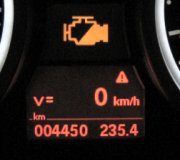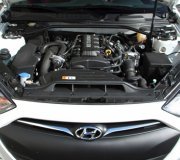All of the inexpensive code readers just read engine codes, but from what I have read, there are some now that claim to read anti-lock brake system codes. If you are going to have more use for this, my recommendation is to check eBay for an older scanner.
When I worked for a very nice family-owned Chrysler dealership in the 1990's, I bought a Monitor 4000 so I did not have to wait my turn for the factory scanner. Later, the dealer gave me one of their Chrysler DRB2s that did not work. Being the electrical genius I claim to be, I fixed it. These two scanners look identical and are built by the same company. Both use a plug-in cartridge, but they do not interchange. Look on eBay for a DRB2, and a "Supercartridge" with a yellow label. That will cover all the model years up to 1995 and all the car models with just one cartridge. If you find older cartridges, each one covers only certain models.
The Monitor 4000 basic cartridge covers GM, Ford, and Chrysler products up to the year listed, but aftermarket scanners never do quite as much as the manufacturer's stuff. This one just does it on more brands. The reason I bought this scanner is it came with a free cartridge specifically for Chrysler transmissions. In fact, now that I think of it, the standard cartridge is just for engines, not for transmissions. Later, I found an ABS cartridge for this scanner, but I never tried to use it.
I suspect you can find either of these scanners for around fifty bucks. They are obsolete for independent repair shops. I have the newer Chrysler DRB3 for all of my vehicles, but the later versions only work on 1998 through all 2003 models and up to some 2008 models. With separate plug-in cards, it will work all the way back to 1983 models, covering everything the DRB2 can do, and more. With a different plug-in card, it can do emissions-related stuff on any brand of vehicle sold in the U.S. Starting with 1996 models.
A lot of independent shops bought DRB3's because of the ability to work on other brands, but even those are becoming obsolete now. You might ask around at some local shops if they have one they would like to sell. Some would jump at the chance to turn an old piece of equipment into dollars they could use to buy something newer.
If you do not mind spending tons of money, consider Snapon's Solus Edge. These cost under $4,000.00 new, but they gouge you on the annual updates. Those cost $1,000.00, but the trick they pull is you cannot skip any years. If you find one on eBay that has only been updated to, lets say, 2014, to be of value in a shop, you would have to buy the 2015, 2016, and 2017 updates, before you could buy the 2018 update. You could buy a new scanner for the same cost, already updated. For this reason, these scanners lose their value very quickly. In a few years, I'm going to buy one updated to 2015 for my 2014 truck, and never update it further after that. That truck is too new for my DRB3. Last time I checked, these scanners updated to around 2010 to 2014 were going for around $800.00.
Also, look at your favorite auto parts store to see what they have. I have seen some that claim to be full scanners for less than $100.00, but I am sure they will have limitations. A friend bought one of these that will display sensor data, but the readings are updated only about once every four or five seconds. It is real easy to overlook critical glitches when they are so slow. These also only usually show up to four lines of data. My DRB3 shows about twelve lines and it updates really fast.
The other advantage with the better scanners is they are "bidirectional", meaning you can talk back to the computers and command them to do stuff. For example, if you have a bad radiator fan, you have to wait, and wait, and wait for the engine to get hot enough for the fan to turn on, but it never does, so how will you know when you can take voltage readings? With the scanner, you can select the fan relay and have the engine computer cycle it on and off while you poke around in the circuit. The engine does not even have to be running. You can fire injectors, ignition coils, and command the fuel pump to run.
Your car also has a body computer, an airbag computer, and possibly an ABS computer, remote key-less entry module, and traveler computer. Even the instrument cluster is a computer module that can be accessed by scanners. The Chrysler scanners will let you reprogram tire size to adjust the speedometer, and turn on and off customer convenience settings like the speed-sensitive power door locks, and things like that. Once you have a scanner, you will never happy after that with a simple code reader.
Wednesday, December 13th, 2017 AT 5:53 PM



